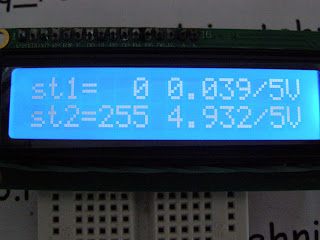I give for tests an old vfd display made by Itron with 20 characters each made with 14 segments, point & comma.
Janos, who is owner of this vfd display, made a interface with 2 MAX6921 integrated, using this schematic:
and PCB board is
I redesigned schematic of vfd interface using Eagle PCB software:
After I study the datasheet of MAX6921, for send data to vfd display, classical style is:
but in my case is little different because I have cascaded 2 MAX6921; for put on vfd display letter R on left corner must send this data:
with this notation of segments of character:
For initial test, I made a simple schematic, using fist time an Arduino Mega board, than Arduino Uno:
When upload VFD_FG209M2_2MAX6921_test1.ini sketch I see X letter moving from right to left of vfd display, like in video named
I made small steps (create characters, like in application note for MAX6954 (see https://www.maximintegrated.com/en/app-notes/index.mvp/id/3211)
until I simulate a clock with calendar and temperature and humidity using VFD_FG209M2_2MAX6921_test3j3c.ini sketch, see movie named afisaj VFD FG209M2 cu MAX6921 si Arduino (9)
Finally, I put in schematic an RTC module with DS3231 (works fine with DS1307, too) and DHT22 module (AM2302 sensor + 4k7 resistor between +5V and DATA pin) for humidity and temperature:
Using RTC_DHT_VFD_FG209M2_2MAX6921_ver4.ino I have on vfd display next texts:
Because texts are in my native language (roumanian) I made few changes for have alternative indications:
I write and upload RTC_DHT_VFD_FG209M2_2MAX6921_ver4a.ino sketch and results can be see in clock on VFD FG209M2 display with MAX6921 and Arduino (2)
I reduce previous sketch and remain just english text for day & day, current sketch is RTC_DHT_VFD_FG209M2_2MAX6921_ver4b.ino and you can see how is now in movie named clock on VFD FG209M2 display with MAX6921 and Arduino (3)
1-March-2021
I received from Janos new info for display
also I received the schematic for power the VFD:































































